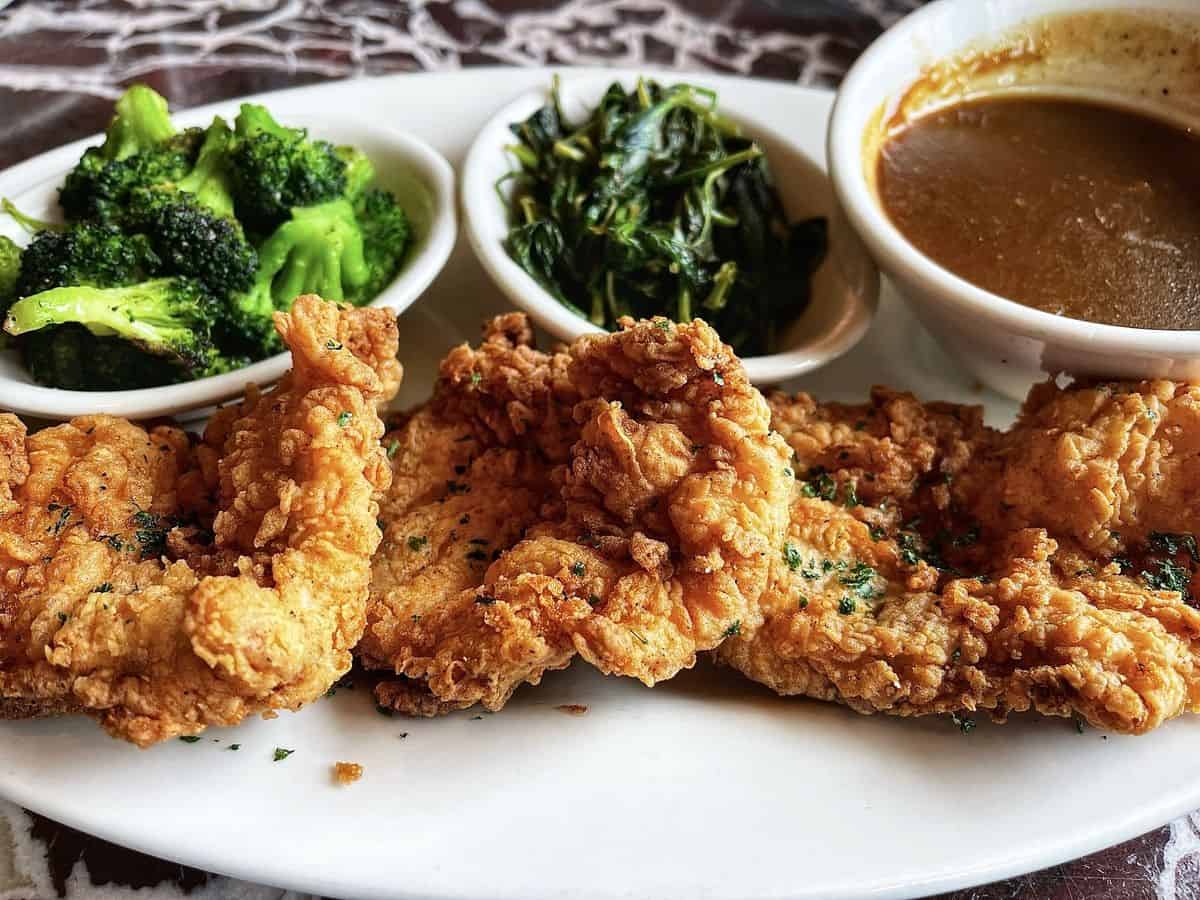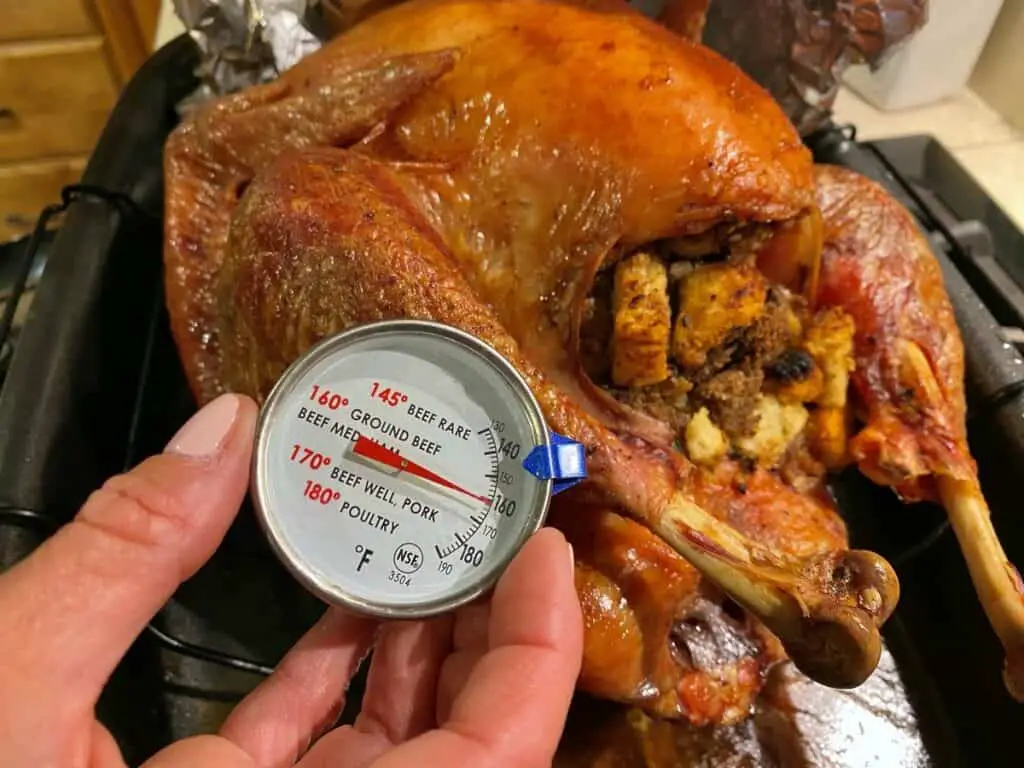Cooking Temperatures For Frying Chicken Perfectly? [Internal and External Temperatures]

Fried chicken is a classic comfort food that’s loved by people all over the world. There’s nothing quite like biting into a perfectly cooked piece of fried chicken.
We all struggle with frying to perfection. Some say frying is an art. Well, I beg to differ slightly it’s more of a technique than art. Mastering the technique is the key to getting scrumptious, delicious, crispy fried chicken.
There are a few key points that one has to master in order to fry chicken properly, well actually these points apply to frying most ingredients to perfection.
To get a perfectly fried chicken you must ensure that the temperature of the oil at which the chicken is added should be 375 F. The chicken should be removed from the oil when the internal temperature is at 165 F any longer the chicken runs a risk of becoming dry and tough from within.
In this article, we’ll explore the science behind frying chicken and explain why the right temperature is so important. Also some really cool tips for achieving that temperature for frying. Additionally, we’ll cover common mistakes to avoid when frying chicken to perfection!
Temperatures You Should Fry At To Get a Perfectly Fried Chicken?
When chicken is cooked at the right temperatures, it will be juicy and tender, with a crispy outer layer. Additionally, cooking the chicken to the right temperature will ensure that it’s not overcooked or undercooked, which can result in a dry, tough, or unsafe dish.
While frying chicken there are mainly two temperatures that need to be looked at. First, the external temperature at which the chicken will be cooked. This is the temperature of the oil that you will be using to fry the chicken.
Secondly, to ensure that the chicken has been cooked properly and thoroughly and is not raw or that the chicken doesn’t overcook and becomes dry and rough from the inside. The internal temperature of the chicken should be at 160 degrees – 165 degrees, nothing higher than that.
The temperature of the Oil (External Temperature)
The temperature of the oil while adding the chicken for frying should be higher than 350 degrees, ideally, at 375 degrees. However, nothing beyond 400 degrees, as it risks burning the outer coating of the chicken.
If the oil goes beyond 400 degrees, the coating will turn brown and finer breadcrumbs will instantly burn and turn black.
If the oil is not hot enough then the breading/ coating, as well as the chicken, will absorb the oil during the frying process and as a result, the chicken will be greasy and the coating will become soggy.
The Temperature Of the Chicken ( Internal Temperature)
The internal temperature of the chicken should be 165 degrees when you take it out of the frying pan or fryer.
It’s important to note that the recommended internal temperature for different parts of the chicken may vary slightly.
For example, the internal temperature for chicken breasts should reach 165°F (74°C), while the internal temperature for chicken thighs and legs should reach 170°F (77°C). This is because the dark meat of the chicken requires a slightly higher temperature to be fully cooked.
How To Tell When Fried Chicken Is Done at the recommended temperatures?
There are several ways to tell when fried chicken is cooked to the right temperature:
Using a Meat thermometer:

Using a meat thermometer is the most accurate way to tell when fried chicken is cooked to the right temperature. Insert the thermometer into the thickest part of the chicken, such as the breast or thigh, to check the internal temperature. The internal temperature should reach 165°F (74°C) for chicken breasts and 170°F (77°C) for chicken thighs and legs.
If You Don’t Have a Meat Thermometer:
- Use a Kitchen Timer: Timing the cooking process can also help ensure that the chicken is cooked to the right temperature. The cooking time will vary depending on the
- Checking The color: The right color of the chicken will be medium to dark brown. That should happen in about 18 – 20 minutes for the chicken thighs and 8 – 10 minutes for the chicken wings. Chicken drumsticks take about 12 – 15 minutes.
| Sr. No. | Type of Chicken | Time Taken at 350 F |
| 1 | Chicken Wings | 18 – 20 minutes |
| 2 | Chicken Thighs | 8 – 10 minutes |
| 3 | Chicken Drumsticks | 12 – 15 minutes |
Suggested Reading: Pan Frying vs Deep Frying Chicken [The Differences Debate!]
Factors That Can Affect the Cooking Time and Temperature of Fried Chicken
Several factors can affect the cooking time and temperature of fried chicken, which can impact the texture and flavor of the finished dish. Here are some of the factors to consider when frying chicken:
- Size and Thickness of Chicken Pieces: The size and thickness of chicken pieces can significantly affect the cooking time and temperature. Large, thick chicken pieces will take longer to cook than small, thin pieces, and may require a lower cooking temperature to ensure that the chicken is cooked evenly without burning on the outside.
- Type of Oil: Different types of oil have different smoke points, which is the temperature at which the oil begins to smoke and break down. Using an oil with a low smoke point, such as olive oil, can result in a burnt or off-flavor in the chicken. Oils with higher smoke points, such as canola or vegetable oil, are recommended for frying chicken.
- Frying Pan Size: The size of the frying pan can affect the cooking time and temperature of fried chicken. A smaller pan may require a lower temperature to ensure that the chicken is cooked evenly, while a larger pan may require a higher temperature to maintain the oil temperature.
- Chicken Temperature Before Frying: The temperature of the chicken before frying can affect the cooking time and temperature. If the chicken is too cold, it may lower the temperature of the oil and result in uneven cooking. Letting the chicken come to room temperature before frying can help ensure that it cooks evenly.
Common Mistakes to Avoid When Frying Chicken
There are several common mistakes to avoid if you want to achieve the perfect texture and flavor. Listed here are some of them to avoid when frying chicken:
- Frying Chicken Straight from the Fridge: Frying chicken straight from the fridge can lower the temperature of the oil and result in uneven cooking. Instead, let the chicken come to room temperature before frying to ensure that it cooks evenly.
- Using the Wrong Oil: Using the wrong oil can result in a burnt or off-flavor in the chicken. Use an oil with a high smoke point, such as canola or vegetable oil, for frying chicken.
- Not Drying the Chicken Properly: If the chicken is not dried properly before frying, it can result in the chicken being greasy or not crispy enough. Pat the chicken dry with paper towels before adding it to the hot oil.
My Fried Chicken Is Not Crispy? [Avoid Making These Common Mistakes] is an in-depth article on our website that covers all the possible mistakes that could have been made to end up with a soggy greasy chicken.
![Can You Use Regular Milk to Fry Chicken?[ Is It Okay?]](https://myhousehacks.com/wp-content/uploads/2023/02/ezgif.com-gif-maker-2023-02-16T162606.222-768x576.jpg)
![Is Pizza and Pasta Flour the Same? [Here’s the Difference!]](https://myhousehacks.com/wp-content/uploads/2022/07/pizza-pasta-dough-768x512.webp)
![Difference Between Pasta And Noodles? [Is There Any?]](https://myhousehacks.com/wp-content/uploads/2023/01/ezgif.com-gif-maker-38-768x576.jpg)
![Does Cooked Pasta Go Bad? [Here’s What to Know!]](https://myhousehacks.com/wp-content/uploads/2022/07/Pasta-1-768x512.webp)
![Fried Chicken vs Grilled Chicken [ 8 Differences with Calories!]](https://myhousehacks.com/wp-content/uploads/2023/02/ezgif.com-gif-maker-2023-02-17T181635.944-768x576.jpg)
![Should You Put Ketchup on Macaroni and Cheese? [Is It Weird!]](https://myhousehacks.com/wp-content/uploads/2022/12/ezgif.com-gif-maker-7-768x576.jpg)
